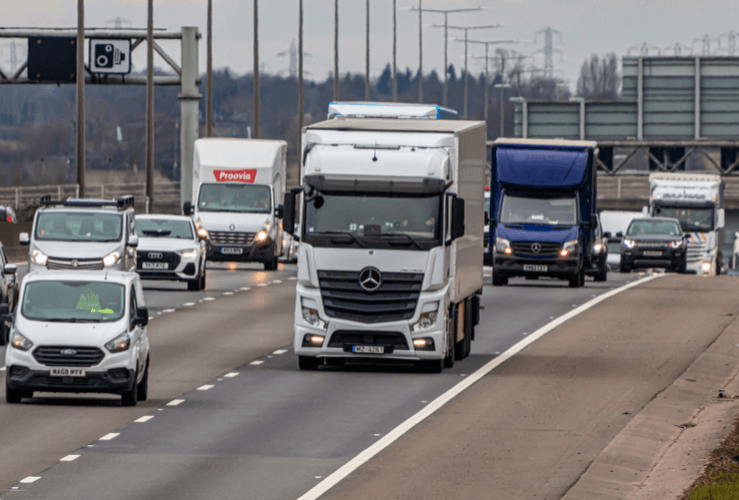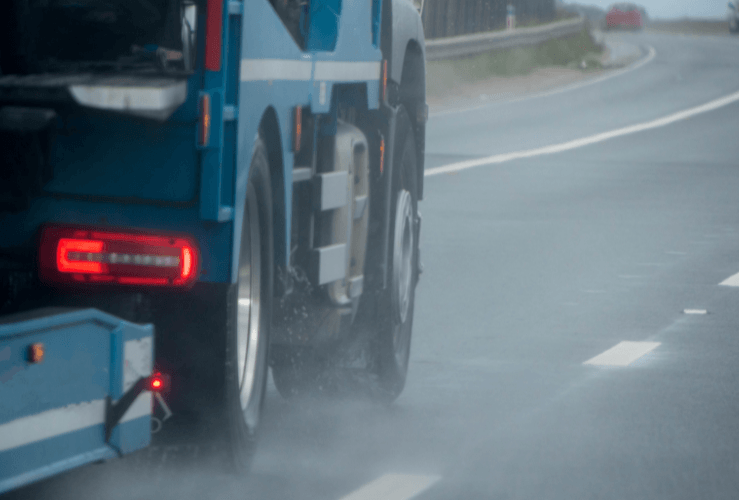Due to their size and restricted speed, driving behind a HGV demands extra care - not least because if you come into contact with such a vehicle, you will almost certainly come off worse.
The most challenging aspect of dealing with HGVs and larger vehicles is overtaking.

Even for an experienced driver, the prospect of overtaking a HGV or large vehicle can be daunting.
For new drivers, such a manoeuvre can be even more stressful - especially for the first time.
In this article we'll look at how to drive behind - and overtake - an HGV safely.
Quick tips for sharing the road with HGVs/larger vehicles
- Leave more space between you and the HGV: The extra weight of a HGV means their stopping distances could be 50% more than a car. For example, a lorry travelling at 60mph could need 132m to stop. This distance could be considerably longer in bad weather, or if the driver is tired or distracted.
- Know that an HGV takes longer to accelerate, especially when starting on an incline or ascending a hill.
- HGVs are restricted to 50 mph on a single carriageway and 60mph on a motorway or dual carriageway. Adjust your speed accordingly.
- HGVs can only use lanes 1 or 2 on a three lane motorway, or lanes 1, 2 and 3 on a four-lane motorway.
- Abnormal or wide-load vehicles have even poorer visibility than HGVs, and may take up more than a single lane. Because of their slower speed and size, they may be very difficult to overtake; this is why they often pull over to allow traffic to pass.
- When joining a motorway ahead of a HGV, ensure there is enough space. Remember HGVs have poorer visibility than regular cars.

HGV roundabout tips
HGVs and larger vehicles require more space when manoeuvring - especially on a roundabout.
This situation can be worsened by the fact lorry steering is not always 100% accurate.
- Stay behind the HGV on a roundabout
- Do not undertake an HGV on a roundabout
- Give the HGV extra space to manoeuvre safely
- If you undertake and an accident happens, you could be at fault
Overtaking HGVs: Why is it more difficult to overtake a large vehicle?
Overtaking is inherently risky, whether the vehicle is the same size as yours, or several times as long. However, because HGVs are so long, you need to ensure you have enough time and space to complete the manoeuvre safely.
You must decide whether it is safe to overtake.
Naturally, overtaking is necessary to reach your destination in a timely manner, and from a wider perspective, to keep the nation's traffic moving swiftly.
However, only overtake when it is safe to do so. Even if traffic is queuing up behind you, do not be tempted to overtake until it can be done in a safe manner.
Because a HGV has so much mass, if a collision occurs there is a higher likelihood of injury or death.

Credit: JarekKilian - stock.adobe.com
Three tips for overtaking HGVs and larger vehicles
1. Ensure the HGV driver can see you
It is important the driver of the vehicle you wish to pass can see you. This means staying out of its blind spots - which on a larger vehicle are bigger than on a regular car.
If you can see the driver's wing mirrors, they should be able to see you. (Note: this may not be the case with a left-hand drive HGV - see below).
Drop back so that you have a better view of the road ahead - and so the driver is better able to see you. Staying too close to a HGV will limit your view of the road ahead - and could be dangerous if they make an emergency brake.
2. Ensure there is room to pass
Naturally, it will take longer to pass a HGV or larger vehicle than a normal car. Ensure there is space on the road to do this.
On a single carriageway, ensure there is no oncoming traffic and of course, never overtake on a bend or corner where you can’t see the road ahead.
Additionally, make sure there is enough room in front of the vehicle, so you can enter the lane safely.
Without enough space, the driver of the HGV will not be able to stop safely in the event you need to brake in front of them.
3. Allow the driver more space if turning
When performing a turn, an HGV driver may not be able to see you. For this reason avoid passing them when they are making a turn.
A HGV will probably need more space to make a turn - and at an intersection may need to cut a corner.
Stay out of a HGV's blind spot
HGVs and larger vehicles have wider blind spots. Try to stay out of these as much as possible.
If you stay in an area of limited or no visibility, the driver of the HGV may become unaware of your presence behind them - which could spell danger if they need to brake rapidly, or if you decide to overtake suddenly.
Once again, if you can see their wing mirrors, they should be able to see you.
Left-hand drive HGVs
HGVs from the continent will be left-hand drive, which means the driver sits on the left of the cabin. This reverses where their blind spots are compared to a UK HGV, and gives them a poorer view of the road.
Non-UK numberplates could indicate a left-hand drive HGV. However, you should exercise extreme caution near HGVs no matter if they are left or right hand drive.
Do not follow an overtaking vehicle
When traffic builds up behind a slower moving HGV, there can sometimes be a "free for all" when an opportunity to overtake arises.
However, it's best not to follow a vehicle that is overtaking a long vehicle, since there is less room if a problem develops. For example, if another vehicle appears in the other lane, as the second overtaking vehicle you will have less time and space to react.
Do not cut in too quickly
Once you have overtaken a HGV, do not cut in too rapidly, since this may compel the driver to brake quickly in order to maintain a safe distance between them and you.
Forcing a HGV to brake suddenly in this way could also have repercussions for any traffic behind.

Take extra care when overtaking in rain
Overtaking a HGV or lorry during heavy rainfall will likely result in your windscreen being sprayed in water, which could reduce your visibility to almost zero. Naturally, this is a highly dangerous situation when overtaking a long vehicle - especially on a single carriageway.
Look out for 'no overtaking' signs
A 'No overtaking' sign is a red ring containing one black and one red car.
If you see this, overtaking is not safe on that stretch of road.
Additionally, if the road has been marked with unbroken double white lines, overtaking is not safe - generally due to poor visibility.




